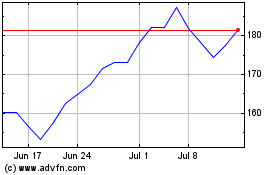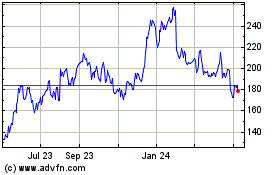By Sara Castellanos
Information-technology executives are pushing to make their
systems more energy-efficient, developing and tweaking software to
cut waste and tracking how much energy their operations
consume.
The trend is partly driven by board-level sustainability
mandates. But in many cases IT leaders are choosing to play a
bigger role in reducing the energy consumption of the hardware and
software at the core of their companies. A crucial part of that is
companies' move to the public cloud, which cuts down on
energy-guzzling data centers.
"The beauty is that things that are sustainable are actually
good for the company, even monetarily," said Sri Viswanath, chief
technology officer at Atlassian Corp., a Sydney-based maker of
online collaboration tools for businesses.
Atlassian aims to run all its direct operations, primarily
buildings, on 100% renewable energy, including wind and solar, by
2025. The company has 12 offices in seven countries. Its Mountain
View, Calif., office is already fully powered by renewable
energy.
The company shut down its data centers about three years ago and
moved to Amazon.com Inc.'s public cloud in part to reduce the
company's carbon footprint, Mr. Viswanath said. His technology team
also rebuilt the code underlying two of Atlassian's biggest
products in part so that software developers used less computing
power, which resulted in less energy use. That project took about
two years.
Carbon emissions are expected to surge as emerging technologies
such as artificial intelligence and blockchain become mainstream
and require more computing power.
Developing a single AI model can have a carbon footprint
equivalent to the lifetime emissions of five average U.S. cars,
according to a paper published this month by researchers at the
University of Massachusetts, Amherst.
U.S. carbon emissions rose 3.4% in 2018 after three years of
declines, representing the biggest jump since 2010, when the
economy was rebounding from the recession, The Wall Street Journal
reported.
"We should always be looking at how the technology we manage and
support can have a role in sustainability," said Juan Perez, chief
information and engineering officer at United Parcel Service
Inc.
UPS drivers have been using proprietary software since 2016 that
calculates massive amounts of data to give them optimized routes.
The tool saves UPS about 100 million miles annually, which
translates to a reduction of 10 million gallons of fuel and 100,000
metric tons of carbon-dioxide emissions, the company said.
UPS is developing tools aimed at optimizing daily package flow
throughout the company's U.S. network of package-sorting
facilities, which will also help reduce emissions, Mr. Perez
said.
The internet, including computing infrastructure, could use up
to 15% of all the world's electricity and emit up to 7% of the
world's energy-related carbon emissions by 2030, says Anders
Andrae, a researcher at Huawei Technologies Co. That's up from
about 7% and 3% today, respectively.
One common way that IT departments waste energy is by
over-provisioning, or buying more computing or storage capacity
than their servers need. Being able to pay for what you use, which
cuts costs and saves energy, was a major reason that online crafts
marketplace Etsy Inc. shifted to Google Inc.'s cloud.
"We knew we were wasting a ton of energy in the data centers,"
said Mike Fisher, Etsy's chief technology officer, who oversees 400
engineers. The company aims to be wholly powered by renewable
electricity by 2020. As part of that effort, it is investing in
solar farms and other projects.
Mr. Fisher's team has also made tweaks to save energy, and
money. Certain data-processing jobs for AI algorithms, for example,
are run on virtual machines that ultimately use less energy because
they offer flexible computing power and can be shared among
Google's other enterprise customers.
Sustainability is also becoming a selling point for vendors.
Chris Wellise, chief sustainability officer of Hewlett Packard
Enterprise, said about $312 million of revenue, or 1% of the
company's total revenue of $30.9 billion for fiscal year 2018, was
attributed to deals closed based on sustainability conversations
with customers.
Mr. Wellise expects revenue from such products to increase by up
to 30% a year, not just for sustainability reasons but because they
save money. The sector includes software tools that let IT
departments identify "zombie servers" and other hardware components
that are wasting energy because they aren't being used.
Salesforce.com Inc. recently developed a prototype of a software
application that lets companies measure, analyze and manage carbon
emissions from data centers, offices, employee commutes and
business travel, because sustainability issues are a growing
priority.
"We are seeing a huge increase in how much people are asking
about it -- CIOs, employees and customers," said Patrick Flynn,
vice president of sustainability at Salesforce.
The app, currently being rolled out to 10 initial customers,
pulls carbon-emissions data through application programming
interfaces -- pieces of software that enable apps, platforms and
systems to connect with each other and share data.
Emissions from Salesforce's data centers have increased to
244,000 metric tons of carbon-dioxide equivalent in fiscal year
2019 from 149,000 tons in 2017. But the company says its total
carbon emissions are offset by measures it takes to avoid, reduce
and mitigate energy use.
Electronic-signature technology company DocuSign Inc., one of
the Salesforce app's beta customers, began formally prioritizing
sustainability in 2015. It uses the public cloud in part for
energy-efficiency reasons.
Kirsten Wolberg, DocuSign's chief technology and operations
officer, said she is changing her team's third-party-supplier
processes to evaluate vendors' focus on sustainability. "I'm
turning that lens back on my own corporate data centers, looking to
see where we can be more green," she said.
Write to Sara Castellanos at sara.castellanos@wsj.com
(END) Dow Jones Newswires
June 24, 2019 05:44 ET (09:44 GMT)
Copyright (c) 2019 Dow Jones & Company, Inc.
Atlassian (NASDAQ:TEAM)
Historical Stock Chart
From Mar 2024 to Apr 2024

Atlassian (NASDAQ:TEAM)
Historical Stock Chart
From Apr 2023 to Apr 2024
